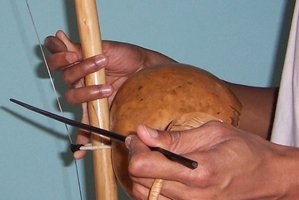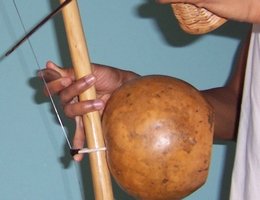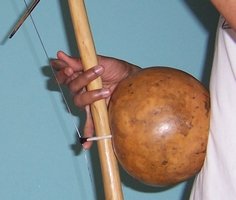Berimbau – How to Play
Okay, you know what a berimbau is, how to set it up and how to hold it...
Sweet!
The next step is the best...playing it!
To do that, you have to start off at square one, learning the basic notes...
Basic Notes
The berimbau has three basic notes which are the foundation for all capoeira toques (rhythms). When combined together they create the wide variety of rhythms available. That makes learning them essential to playing this musical bow. Luckily, they're pretty simple and straight forward.
 Open – On the open note, the player holds the dobrão away from the arame, using the baqueta to strike the arame below the dobrão. The cabaça is held away from the body when playing this note.
Open – On the open note, the player holds the dobrão away from the arame, using the baqueta to strike the arame below the dobrão. The cabaça is held away from the body when playing this note.
 Closed – On the closed note, the player holds the dobrão firmly against the arame, using the baqueta to strike the arame above the dobrão. Like the open note, the cabaça is held away from the body when playing it.
Closed – On the closed note, the player holds the dobrão firmly against the arame, using the baqueta to strike the arame above the dobrão. Like the open note, the cabaça is held away from the body when playing it.
 Buzz – On the buzz note, the player holds the dobrão loosely against the arame, using the baqueta to strike the arame above the dobrão. On this note the cabaça is held against the body, muffling the sound. This is the trickiest of the basic notes to play.
Buzz – On the buzz note, the player holds the dobrão loosely against the arame, using the baqueta to strike the arame above the dobrão. On this note the cabaça is held against the body, muffling the sound. This is the trickiest of the basic notes to play.
Now that you know the basics, it's time to move to the fun stuff!
Other Sounds
In addition to the basic notes, there are other unique sounds the berimbau makes that give the flavor to the rhythms in capoeira. They require a little practice, but are worth it when you add them to your playing!
- Wah-Wah – This is the effect of playing an open note while moving the cabaça back and forth against and away from your body. It's used a lot in playing normal open notes, where the cabaça starts against the body and when the note is struck, moved away.
- Dobrão on Note – This effect is created by pressing and releasing the dobrão against the arame after playing a note. It causes the note to change pitch, higher when pressed and lower when released.
- Caxixi – The caxixi can be played as its own sound. By striking with the baqueta in different ways, the caxixi can either be silent, or make a lot of noise. This is one that I'm still learning ;)
- Loose Baqueta – When the baqueta is held loosely and struck against the arame, it can vibrate against the wire creating an interesting effect. Think of the sound a woodpecker makes.
All of these sounds become important to know when playing certain toques (rhythms) such as Iuna and Miudinho. To learn them, the first step is to practice!
Practice Exercises
Like anything in life, to get good, you need to practice!
Here are some basic exercises I used to make the most out of my practices as a beginner.
- Basic Notes Switch – When just starting, I needed to get used to the basic notes. For this I just practiced each basic note repeatedly and practiced transitioning between them. So for instance, I would play the open note 8 times, followed by the closed note 8 times, followed by the buzz note 8 times, back and forth so my transitions were smooth.
- Mimic Music – This sounds hard, but it really just takes patience. I'll listen to capoeira music with rhythms I can clearly hear and listen to it repeatedly while trying to mimic the sound on my berimbau. Eventually you start to pick up the rhythms easier.
From here, it's all up to you how good you get with the berimbau. The more you practice and put time into playing, the more you'll pickup and smoother you'll get in playing. My personal experience is the more you play the funner it gets. Trust me, it's worth it!
Return from Berimbau - How to Play to Capoeira Instruments
Return to Start Playing Capoeira



 Open – On the open note, the player holds the dobrão away from the arame, using the baqueta to strike the arame below the dobrão. The cabaça is held away from the body when playing this note.
Open – On the open note, the player holds the dobrão away from the arame, using the baqueta to strike the arame below the dobrão. The cabaça is held away from the body when playing this note. Closed – On the closed note, the player holds the dobrão firmly against the arame, using the baqueta to strike the arame above the dobrão. Like the open note, the cabaça is held away from the body when playing it.
Closed – On the closed note, the player holds the dobrão firmly against the arame, using the baqueta to strike the arame above the dobrão. Like the open note, the cabaça is held away from the body when playing it. Buzz – On the buzz note, the player holds the dobrão loosely against the arame, using the baqueta to strike the arame above the dobrão. On this note the cabaça is held against the body, muffling the sound. This is the trickiest of the basic notes to play.
Buzz – On the buzz note, the player holds the dobrão loosely against the arame, using the baqueta to strike the arame above the dobrão. On this note the cabaça is held against the body, muffling the sound. This is the trickiest of the basic notes to play.